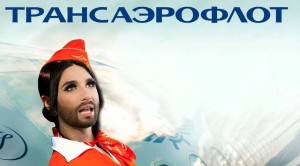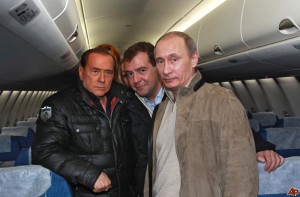
For the last 25 years Russia’s civil aviation has been going through tough times. Even such a hard core patriot as Deputy Prime Minister Dmitri Rogozin admits this fact. Yet another problem has recently emerged on top of the worn-out state of the aircraft fleet and airport infrastructure and the unprofitability of aircraft manufacturing. The only new civilian aircraft project developed in the last 20 years, Sukhoi Superjet-100, could fail as a result of international sanctions introduced in response to Russia’s aggression against Ukraine. The manufacturer has expressed concern about possible difficulties with the procurement of foreign parts, the share of which in the construction of the Russian Superjet is obscenely high and exceeds 50 percent.
However, the absence of new Russian-made aircraft will not have any considerable effect on Russia’s air passenger travel market. According to the Russian State Research Institute of Civil Aviation, the share of domestic passenger aircraft in Russia’s fleet hardly reaches 8 percent, with Aeroflot being the only Russian airline to increase this number, mainly by introducing the abovementioned Superjets. Other Russian airlines do not seem to be eager to buy those jets, not to mention the fact that the state-controlled Sukhoi Civil Aircraft Corporation is unable to meet the demand of Russia’s aircraft fleet that, according to some estimates, will reach 1300 airplanes by 2034. There is an enormous gap between supply and demand. In 2014, only 43 aircraft were built in Russia, with 11 of them having been sold to foreign buyers. In this context, Prime Minister Medvedev’s statement about the reasons for the recent acquisition of a major Russian private company, Transaero, by the state-owned Aeroflot–“they have more than enough machines, they bought extra ones when the industry experienced a peak and miscalculated” –sounds, at the very least, like a ruse. Transaero had been increasing its fleet in response to a growing demand in air transportation and had been successfully competing with Aeroflot for 20 years before getting insolvent in 2015 as a result of the economic crisis in Russia that was characterized by the fall of the ruble against major currencies, a decline in tourist flow, and a slump in demand in international and domestic air transportation, that Medvedev prefers not to mention.
It is unlikely that Transaero was punished for its refusal to purchase Russian-made planes, and it remains unclear whether Aeroflot itself needed this acquisition. One thing is certain: as a result of this merger, the state-owned Aeroflot now controls more than half of Russia’s passenger air travel and is fast approaching a position of total monopoly on the market.
In the modern world, airlines are less connected to national markets; strict government regulation of the industry and a desire to support the national carrier whatever the cost have become things of the past. Thus, in the last 10 to 15 years alone, the European market has witnessed several mergers and acquisitions of national airlines: in 2004, Air France has merged with the Dutch KLM; in 2010, British Airways with Spain’s Iberia, while the German Lufthansa, Europe’s largest airline, now includes Swiss and Austrian, which also used to be national carriers. Furthermore, even Lufthansa accounts for less than 15 percent of Europe’s air travel.
Competition between national airlines has been replaced by a Europe-wide competition: no country now attempts to preserve the dominant position of its airline at any cost. The winners of this situation are passengers, for whom a healthy competition between traditional carriers as well as discount airlines such as Ryanair and EasyJet, which have emerged and grown substantially within the last 20 years, have meant lower ticket prices, expanded routes, and a higher quality of service.
The North American market, where several large privately owned airlines constantly compete with each other (and sometimes merge or declare bankruptcy,) has changed in a similar way in the past 10 years. In 2008, Delta merged with Northwest, as as result becoming the world’s largest airline in terms of aircraft fleet and travel volume. In 2010, after its merger with Continental, United has, for a few years, become the world’s largest airline. In 2014, after its merger with US Airways, American has become the world’s largest carrier. It should be noted that the existence of a

few large carriers–none of which controls even 20 percent of the market –is already causing concern on the part of the US government, because in theory this situation could lead to reduced competition and negative consequences for passengers.
The emergence of a carrier that controls more than 50 percent of the Russian air travel market–which is already closed to foreign participants–could lead not only to increased ticket prices, but also to a slowed or halted development of the routes network and to other negative consequences. It is difficult to say now where exactly this could lead. Thus, Russia’s Economic Development Ministry does not see anything wrong with Aeroflot’s acquisition of Transaero, although there are also different opinions. Although, if one recalls statements from the authorities about a possible impending privatization of the main national carrier, given the Kremlin’s traditions it is not difficult to foresee exactly how this privatization will be conducted, and which of Putin’s Western-sanctioned friends will get their hands on almost all of Russia’s air travel market.





